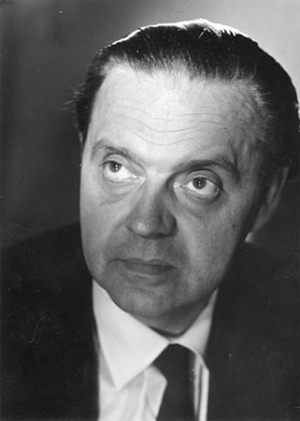Gallery
All Pictures (5)Biography
Géza von Radvanyi, born as Géza Grosschmid on 26 September 1907 in Kassa, Austria-Hungary (now Košice, Slovakia) is the son of a politician and the younger brother of the writer Sándor Márai. He went to Paris, Geneva, Madrid and London from the 1920s on as a foreign correspondent for Hungarian daily newspapers. In the 1930s he moved to Berlin, where he became acquainted with working in film and was hired as an assistant to directors Viktor Tourjansky and E.A. Dupont, among others. From 1930 to 1937 he was married with Eva Daghofer, the daughter of actress Lil Dagover. Then he met the Hungarian actress Mária von Tasnády who appeared in movies of Detlef Sierck and Herbert Maisch, he married her and returned to Hungary with her in 1939 shortly before the war began. There Radvanyi directed for the first time some movies with Tasnády in the leading role, among them the first colour movie of the country, "Egy asszony visszanéz" (1941, "A Woman Looks Back"). In 1942 the couple shot the film "Inferno giallo" in Rome.
After the end of the war Radvanyi taught at the reorganized Academy for Acting and Film in Budapest. As early as 1945, he met the film theorist Béla Balázs, who had returned from exile in Russia, and who gave him the inspiration for his most important film, "Valahol Európában" (1947, "It Happened in Europe") about a group of homeless children who wander the streets of an unspecified country during the war. The film, documentary in style and based on Italian Neorealism, received international recognition; it was not distributed in Germany however.
In Italy, Radvanyi made "Donne senza nome" (1949, "Women Without Names") which is similar in style to "Valahol Európában" and tells the story of women who are interned in a camp for 'displaced persons' after the war. He then filmed the love story "L'Étrange Désir de monsieur Bard" (1953, "Strange Desire of Mr. Bard") in France, before he came to Germany in 1954 and made a series of entertainment films, such as "Ingrid. Die Geschichte eines Fotomodells" ("Ingrid - The Story of a Fashion Model", 1954) with Johanna Matz and Paul Hubschmid, "Der Arzt von Stalingrad" ("The Doctor of Stalingrad", 1958) after Konsalik with O.E. Hasse and "Mädchen in Uniform" ("Girls in Uniform", 1958) with Lilli Palmer and Romy Schneider, a remake of the pre-war film of the same name by Leontine Sagan and Carl Froelich.
For Artur Brauner's production company CCC he created "Das Riesenrad" (1961), a Viennese family chronicle of three generations, and the Simmel adaptations "Es muss nicht immer Kaviar sein" ("Operation Caviar") and "Diesmal es muss Kaviar sein", all starring O.W. Fischer in the leading role. "Uncle Tom's Cabin" (1965) was a splendidly designed international large-scale production, also starring O.W. Fischer. Radvanyi's last directorial work for the time being, "Der Kongreß amüsiert sich" ("Congress of Love", 1966) was a remake of Erik Charell's music film "Der Kongreß tanzt" ("Congress Dances") from 1931.
After that Radvanyi still wrote scripts occasionally, finally returned to Hungary and in 1980 he shot the melancholic "Circus Maximus" about a circus troupe travelling through Germany shortly before the end of World War II and helping persecuted people to flee to Yugoslavia.
Géza von Radvanyi died in Budapest on 26 November 1986.
